
views
Visiting the Space
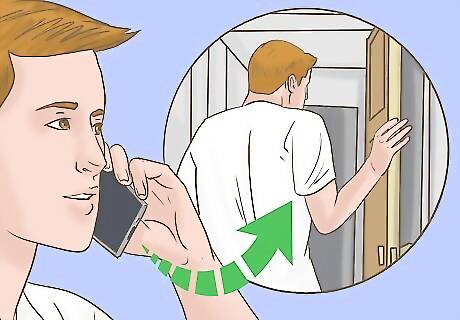
Ask to do a walkthrough of the area you’ll be cleaning. Call your potential client and ask them if you can look at the space ahead of time. Schedule a time that works for both you and the client so you can visit the areas that need to be cleaned. Seeing the area firsthand can help you determine the size and scope of what you need to complete throughout the job. Taking the time to do a walkthrough also shows your client that you’re willing to put in extra time and care to give them a fair and honest deal.
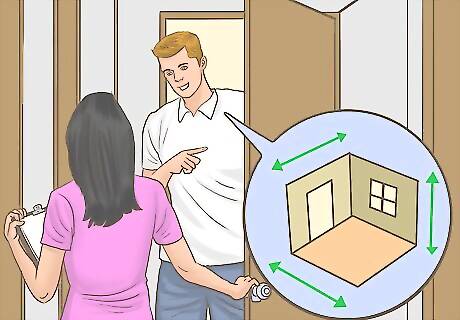
Request the measurements of the spaces you’re going to clean. Your client should have the measurements of each room so you can determine the size of the space. Larger projects require more work hours and manpower than smaller areas. Ask your client as soon as you arrive if they have specific measurements. If measurements aren’t given to you by your client, then be prepared to measure the space yourself. It's a good idea to get this information ahead of time, so consider sending an email requesting the square footage, as well as the number of bedrooms and bathrooms (or offices) before you schedule the walkthrough.

Takes notes on the type of flooring throughout the space. Carry a notebook with you as you do your walkthrough. Write whether the floors are tile, wood, carpet, or another material so you can determine if you need any special cleaners. While carpets may only need to be vacuumed, hard floors should be swept and mopped. If you’re unsure about what material the flooring is, ask the client to clarify so you know for sure.
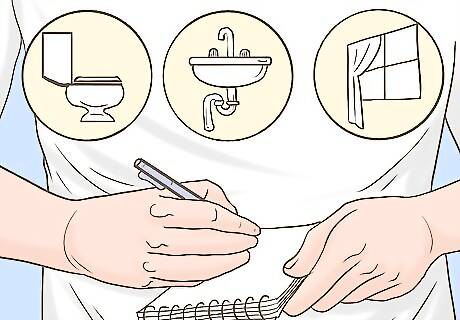
Write down the number of fixtures and windows. Count the number of restrooms, sinks, or any other large fixtures throughout the area. These areas tend to get dirtier and will require more time for you to clean. Then, count the number of windows so you know how much glass you’ll need to clean. Ask if you need to wash the exterior windows as well as the interior.

Photograph the areas the client wants cleaned for reference. Take a digital camera or a smartphone with you during your walkthrough. Get good, clear pictures of each area the client wants you to clean so you can look at them later while writing your bid. The photos can help you remember details about additional work that needs to be done in a specific area. Always ask the client if it’s alright for you to take pictures.

Discuss with the client what special services they expect from you. As you’re walking through the space, ask the client what they want you to clean. Ask them for specific details, like whether desks need to be straightened out, carpets need to be shampooed, or exterior windows should be wiped. Take notes on all the details the client tells you. Getting detailed answers helps you and your client come to an agreement about the expectations and gives you a better idea of what to estimate for your bid. Ask your client what times they expect you to clean and how often you’ll work on site.Tip: Organize your notes by room and list all of the things that need to be cleaned so you can make a more accurate estimate.

Ask the client if they’ll provide any supplies. Some clients will give you supplies, such as toilet paper or soap, but don’t offer other cleaning supplies. Ask them if you’ll have access to any supplies on site or if you’ll need to bring your own. As you walk around, make note of any supplies you may need while you’re cleaning.
Estimating the Cost
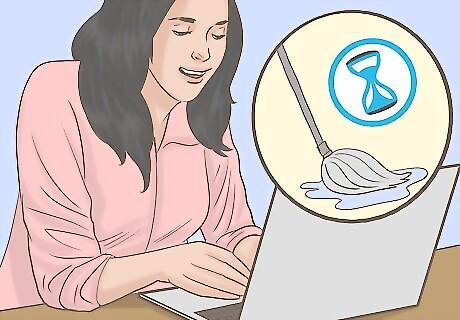
Determine how much time it will take to clean the location. Usually, the amount of time it takes to clean is calculated by the size of the area and the amount of work you need to do. If you’re only doing a light cleaning, such as emptying trash and vacuuming, then it won’t take as much time as a deep clean. Your time may also depend on how many employees you have working and how efficient they are. Many estimate calculators are available online where you can plug in the information to determine how much time you’ll need to spend.

Include costs of any supplies or equipment you need to bring. Look at your notes and pictures of the area you’re cleaning and determine if you need any special cleaners. Make an itemized list of all the cleaners you’ll go through while cleaning and how often you’ll need to replenish them. Determine how fast you go through the products and charge the client accordingly. For example, polishing tile floors requires more time and supplies than just vacuuming a carpet. Even if your client provides some of your supplies, you may need special cleaners or equipment that they aren’t aware of.

Account for employee wages if you have any. If you’re working a larger job that requires more manpower, make sure to include their hourly rate into your costs. After you’ve found out how much time it should take for you to clean the area, multiply that number by the employees that will be working at the job. If you’re only working a small job as an individual, you don’t need to worry about employees.

Add 10% of the costs to your budget for any unforeseen issues. Overhead costs help account for work that you may not have noticed in your first walkthrough. Allow yourself about 10% of the total cost of wages and supplies so you can have enough money to account for any problems that arise along the way.Tip: If there ever is an additional cost that exceeds the estimate you provided, let your client know in advance so you can discuss any charges.

Give yourself a profit equal to 20% of the cost. To make money during a job, find out what 20% of the total estimated cost is so you can keep it as profit. Add your profit to the cost that you’ll charge your client to get a final estimation of what you should charge for your cleaning job. Profits may vary depending on the size of the job. For example, a larger corporate space that’s around 150,000 sq ft (14,000 m) may only give you up to 10% profit, but a space that’s smaller may be easier to turn a larger profit.

Compare your estimate to other cleaning companies in your area. Call other cleaning companies in the area and ask them what they charge for their services. Write down their estimates and compare them to yours to see if you’re charging too much or too little. Make sure your estimate is enough for you to make money but also near your other companies’ prices to remain competitive. Check classified ads and job boards to find other competitors in your area.
Making Your Bid Proposal

Put your contact information at the top of your company’s letterhead. List your name, the company’s name, and a good phone number or email where the client can reach you. This will make it easier for the client to remember your information so they can reach out to you if they have any questions or concerns about your bid.
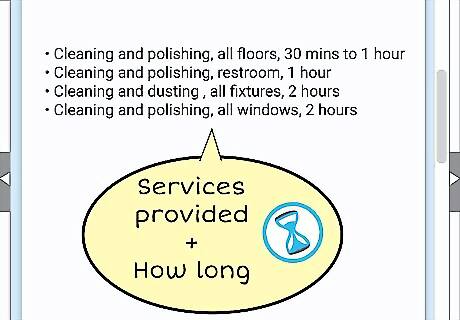
Write the services you’re providing and how long they take. Make sure your list is detailed and thorough so your client knows what to expect each time you’re on site. With each service you write, give your estimation of how long it will take to complete.
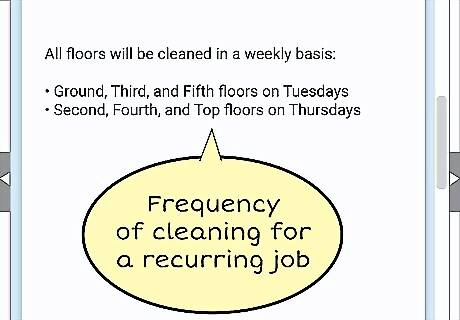
Mention how often you’ll be cleaning. If the bid is for a recurring job, then you’ll need to include how many times you’ll be cleaning the space. Let the client know if you’ll be cleaning, daily, weekly, or monthly depending on what you discussed with them earlier. If you’re working in a large building, specify what areas you’ll clean during specific days. For example, you may clean odd-numbered floors on Tuesday and even-numbered floors on Thursday.
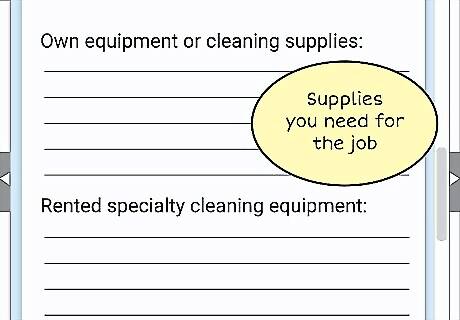
List any supplies you need to bring with you during the cleaning job. If the job requires you to bring your own equipment or cleaning supplies, include what you’re bringing and what you’re using it for. If you need to rent specialty cleaning equipment, make sure to include it in your list of supplies. Only include the supplies that you and the client agreed upon. For example, if they are providing brooms and mops, don’t bring your own and charge them for it. If you need to bring a special cleaning agent that isn’t as common, you can charge an additional price for them.
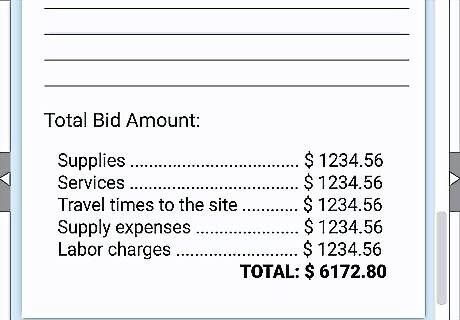
Give the total bid amount at the bottom of your proposal. After you’ve listed all the supplies and services you’re providing, break down your costs so your client knows exactly what they’re paying for. Include travel times to the site, supply expenses, and labor charges for your employees.
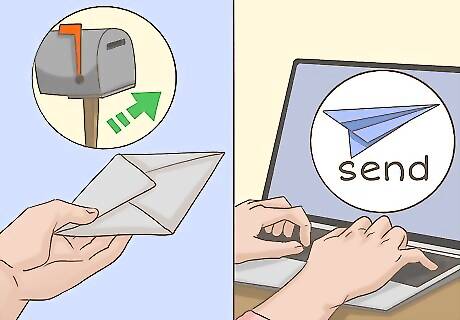
Deliver the bid to your client. Either take your bid directly to the client or send it over an email so they can easily look at it. Provide your contact information so they can reach out to you if they have any questions on your proposal. Give the client 90 days to respond to the proposal and let them know you can’t start working until the bid is accepted. Follow up the next day with a phone call to see if they received your proposal and to establish a good repertoire with the client. If the customer approves your bid, set up your appointment and send any information they request, like your certificate of insurance or your cleaning plans. At that point, the job is active.



















Comments
0 comment